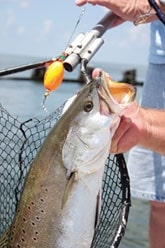
|| |—| || |CORK POPPER: Rattling rigs call in big Indian River gators. Photo: Bob McNally| The popularity of seatrout is easy to understand. Trout are abundant and simple to locate for nearshore anglers. They put up a spunky fight and regularly hit lures and natural baits. They are also outstanding on the table. Although one- to three-pounders are common throughout the range of the fish, big seatroutthose glistening, dime-spotted gators weighing five, eight, ten pounds and morecan only be found in a few select spots. The following five locations are choice if you’re trying to catch the biggest trout of your life.
1. Indian & Banana Rivers, Forida
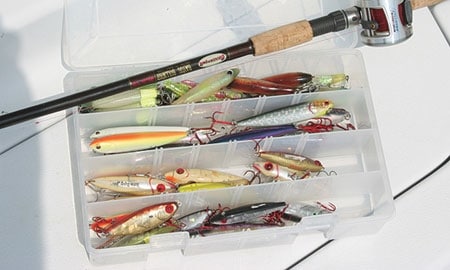
SPECK SELECT: Shallow-running lures are Indian River favorites.
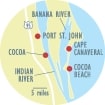
| |Illustration: Bryan Christie| Touted as the Spotted Seatrout Capital of the World, Florida’s Indian and Banana Rivers lay claim to the all-tackle seatrout record of 17 pounds, seven ounces, plus at least nine IGFA line-class records for seatrout over the years.
** * Where to Fish:** The Indian River runs along Florida’s east coast for 100 miles, from Ponce de Leon Inlet near New Smyrna Beach to St. Lucie Inlet at Stuart. The Banana is a large feeder river of the Indian, and the two meet at Cocoa Beach.
Huge seatrout can be caught throughout the lengths of both rivers, and heavy fish can be taken in remarkable abundance virtually year-roundand you don’t even need a boat to do it. The best fishing occurs when seatrout swarm onto shallow grass Flats to feed, where easy wading is often the most deadly way to pursue them. Seatrout fishing from bridges and shorelines can be outstanding as well.
** * When to Go:** Plenty of huge Space Coast seatrout are caught from March through June, with some taken in July and August. Scores of eight- to ten-pound trout are landed annually in the area, so it takes a 12-pounder to make people stop and pay attention.
The best spring and summer fishing is available very early in the morning. Trout are on the Flats until bright sunlight drives them down. When the sun gets high, work deep edges of Flats. Shady areas around bridges are also good places when it’s sunny. Fish bridges after dark as well since trout hold around the edges of areas beneath lights looking for shrimp. Good action is available from the bridges themselves, from boats and sometimes by wade-fishing Flats near lights.
Seatrout fishing in the Indian and Banana Rivers is also excellent in the fall and winter. In moderate weather, fish are still found on the Flats. But in the coldest months of December through February, impressive catches of big fish can be made from deep canals and dredge holes, as seatrout school en masse in the comparatively warm temperatures that the depths provide. There are hundreds of canals off the Indian and Banana Rivers in Brevard County, and about 75 percent of them offer excellent mid-winter seatrout fishing.

| |Excalibur Super Spook Photo: Manfred Koh| ** * What to Use:** Thinking shallow is key when choosing lures for the Indian and Banana Rivers, since many of the biggest trout are caught around grassbeds and docks in water less than a few feet deep. Many anglers prefer topwater plugs, such as the Excalibur Super Spook and various MirrOlures including the Top Dog. Other old favorites among the shallow-water, big-trout gurus on the rivers include the original Boone Zig-Zagger (if you can find one on eBay) and the Rebel Jumpin’ Minnow. Four- to seven-inch soft-plastic jerkbaits that imitate needlefish, such as the Bass Assassin Shad Assassin and Lunker City’s Slug-Go, score on oversize seatrout. D.O.A. Shrimp (three or four inch, in nite glow color) are also prime big-trout lures.
2. Orange Beach & Gulf Shores, Alabama
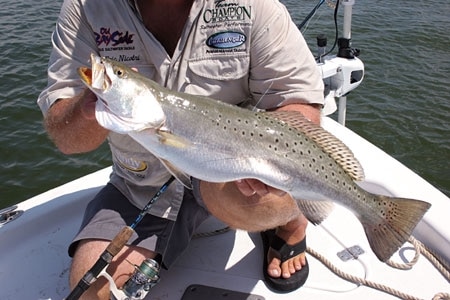
NOON LAGOON: At midday, look for trout to hold along the edges of flats.
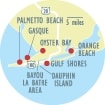
| |Illustration: Bryan Christie| Although other regions of the South are better known for seatrout, this part of Alabama yields a surprisingly large number of five- to eight-pounders. And ten-pound fish are not rare.
** * Where to Fish:** Anglers catch many heavyweight trout along beach sloughs, fishing from shore and boats. Although the entire Alabama coast can offer good action from trout weighing five pounds, including famed Dauphin Island and the Bayou La Batre area, locals say the waters around the towns of Gulf Shores and Orange Beach are prime. Nearby Perdido Pass and Little Lagoon also offer fishermen great shots at trout weighing over the magic five-pound mark. The Fort Morgan area can also be a big-trout hot spot.
** * When to Go:** Summer action for big trout can be good, especially at night for anglers working baits and lures around lighted boat docks. The Ono Island area shines for night dock trout, but big fish are cagey. Beach and pass locations are also prime when big trout turn on in the fall. Anglers catch many heavyweight trout along beach sloughs, fishing from shore and boats. Daybreak fishing often is best, and sloughs typically hold big schools of bait and predators, such as trout, redfish, ladyfish and others.

| |D.O.A. C.A.L. jig with grubtail. Photo: Manfred Koh| ** * What to Use:** Many fish fall to sliding-sinker rigs baited with live croaker, pinfish or bull minnows. Or bait up with a large live shrimp and retrieve it slowly along the bottom. Top artficials include the D.O.A. C.A.L. jig-and-grubtail combo.
3. Charlotte Harbor & Pine Island Sound, Florida
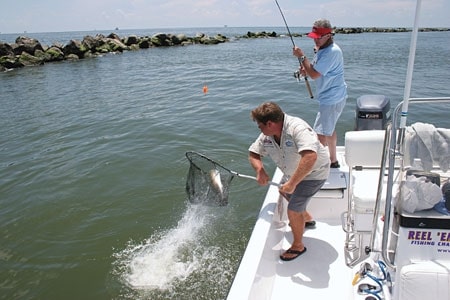
BOAT BOUND: a shrimp-caught speck comes to the net.
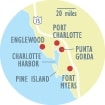
| |Illustration: Bryan Christie| Largely overshadowed by the Indian and Banana Rivers near Cape Canaveral, Florida’s Gulf Coast seatrout fishing is slowly building its big-fish reputation. Since the gillnet ban went into effect ten years ago, trout have blossomed in numbers and size throughout the Gulf of Mexico. And no place on Florida’s Gulf side has better seatrout fishing than Charlotte Harbor and adjacent Pine Island Sound near Fort Myers.
** * Where to Fish:** State biologists tout Pine Island Sound as having some of the healthiest trout habitat in Florida. Both Pine Island and Charlotte Harbor have an abundance of clear, salty water, and miles of verdant grassbedsall necessary elements for big trout. Baitfish and shrimp populations are thriving, so there’s plenty of food for trout to wax large and fat. Scientists say area trout grow to ten inches in their first year, and 20-inch fish are common. Patchy grass areas seem more productive for trout than large, solid grassbeds. The best depth is often three to five feet, and the better places for bigger fish have dropoffs falling six to ten feet nearby.
** * When to Go:** February through April is widely held as gator-trout time in this region. Anything over five pounds is a heavy fish, but some pushing 30 inches are caught. As weather warms in May, most regional anglers chase tarpon and snook, but daybreak and dusk action for seatrout remains excellent. Night fishing around lighted docks and bridges is also productive for all three species.

| |D.O.A. nite glow shrimp Photo: Manfred Koh| ** * What to Use:** Grub jigs are effective as are streamer flies, such as Clouser minnows, and shrimp-imitating lures like those made by D.O.A. Live shrimp also account for plenty of fish. For gator-size seatrout, large plugs may be the way to go. MirrOlures are local favorites, especially the subsurface Catch 2000 and Catch 5 models. Top Dogs, She Dogs and He Dogs are also extremely popular lures.
4. Laguna Madre & Baffin Bay, Texas
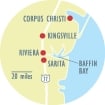
| |Illustration: Bryan Christie| This famed and lightly populated area of southeast Texas has been giving up heavyweight spotted seatrout for generations. Whereas winter kills from cold weather can tumble trout stocks along this shallow, sheltered coast at times, invariably big fish return and anglers follow in droves.
** * Where to Fish:** The Laguna Madre sprawls for miles along the Lone Star coast, and trout reign supreme throughout its length. It’s a pristine region, bordered by huge, inaccessible private ranches on the west shore, south of Corpus Christi. On the east, it’s bounded by Padre Island National Seashore. In between is one of the country’s largest shallow estuaries, with an abundance of grass, bait and clear, high-saline water.
Eight- to ten-pound fish are not uncommon, and trout pushing 12 pounds are seen almost every year. The state-record seatrout of 15.6 pounds came from the area.
** * When to Go:** Year-round big-trout fishing can be good on Laguna Madre. On all but the coldest winter days or the hottest summer ones, heavy trout are available. Spring and fall are best, however, for consistent big-fish catches.
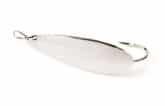
| |Johnson spoon Photo: Manfred Koh| ** * What to Use:** While live baits catch Texas trout, most anglers use luresspoons, grubs, topwaters and suspending plugs. Big mullet are a main forage for big trout, so lures that imitate them succeed. Wading works so well because the Laguna (and its Baffin Bay feeder) are extremely shallow, and spooking big fish is common for anglers working out of boats. Standard procedure for Texas fishermen is to run their boats to productive grass areas, shallow reefs or channels, anchor the boat and get out and wade.
5. Lake Calcasieu, Louisiana
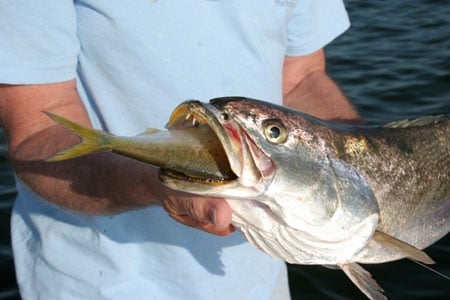
GATOR GULLET: Big specks are predators of the highest order.
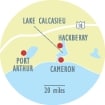
| |Illustration: Bryan Christie| Hurricane Rita crushed many of this hot spot’s fishing infrastructure. But the large inland estuary south of the town of Lake Charles is in great shape and heavy-trout action is red hot. Moreover, most Calcasieu guides are already leading anglers to banner catches, although many are working out of Lake Charles instead of traditional fishing lodges. Many Calcasieu lakeside lodges and fishing facilities should be operational by early summer.
** * Where to Fish:** Local sharpies head for Turner’s Bay Channel Reefs and Turner’s Bay Island in this bay in summer and fall. Look for big trout among oyster reefs, points and cuts in both the lake and its estuaries. Watch for diving birds as trout head to the surface.
** * When to Go:** While fishing on Lake Calcasieu can be excellent year-round, there are peaks and valleys.
April through June is the best and most consistent time for big seatrout, and getting an eight- to ten-pounder is always a possibility. High winds can be a problem early in this phase, but when it’s right, it’s sensational.
July through September also provides steady trout fishing, though spawning-size mega-seatrout are not as common as in spring. October through December is the best time for multi-species trips for seatrout, redfish and Flounder. Plenty of good-size fish are caught: trout to eight pounds, reds to 12 pounds and Flounder to five pounds.
January through March can be good for seatrout, when weather cooperates. Wind muddies the water and can make fishing tough.
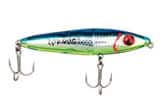
| |MirrOlure Top Dog Photo: Manfred Koh| ** * What to Use:** The bulk of Calcasieu trout are caught with artificials, mostly grub jigs, but heavy fish frequently are taken on big topwater plugs, such as Top Dogs and other Floating MirrOlures. Rebel Wind Cheater Floating-diving plugs also score, because they can be cast a country mile to reach wary seatrout, and offer a nervous, twitching-and-diving action that gator trout can rarely resist.
Gator Guides
Indian & Banana Rivers, Florida
Marsha Foosaner, (772) 287-5377
Dave Brown, (386) 427-1991
Orange Beach & Gulf Shores, Alabama
Tim String, (251) 610-7849
Jesse’s Trout Lodge, (877) 228-2486
Charlotte Harbor & Pine Island Sound, Florida
Paul Hobby, (239) 433-1007
Blake Matherly, (239) 671-5646
Laguna Madre & Baffin Bay, Texas
Cliff Webb, (361) 949-0707
Jay Watkins, (361) 729-9596
Lake Calcasieu, Louisiana
Hackberry Rod & Gun Club, (888) 762-3391
Calcasieu Charter Service, (337) 598-4700









